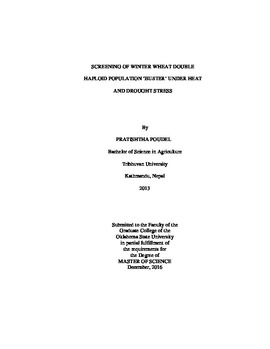| dc.description.abstract | The major abiotic stresses associated with wheat production throughout the world are heat and drought. The objective of this research was to screen a double haploid (DH) ‘Buster’ population to identify and select DH lines with improved drought and heat resistance. Four separate studies evaluated the response of DH population to no stress, high temperature stress, drought stress, and combined high temperature and drought stress in controlled conditions at Oklahoma State University, Stillwater, OK. One hundred lines from the DH Buster population, developed from a cross of the wheat varieties ‘Billings’ and ‘Duster’, were used for the first two studies and 33 lines from the same population were used for the remaining studies. Different morpho-physiological parameters including photosynthetic pigments, tiller numbers, plant height, per unit area leaf photosynthesis, transpiration, stomatal conductance, intercellular CO2 concentration, electron transport rate, fluorescence, instantaneous water use efficiency (IWUE), membrane thermal stability, carbohydrate remobilization, spike photosynthesis and spike and stem weights were recorded depending upon the specific objective of each study. A portable photosynthesis and fluorescence system was used to measure gas exchange parameters of leaf and spike. The defoliation treatment imposed in the drought study enabled to decipher the contribution of carbohydrate remobilization from the stem towards grain yield. Results from screening under stress free conditions showed significant differences between 100 DH lines for plant height, tiller numbers, and leaf area. Similarly, DH lines were significantly different for gas exchange and fluorescence parameters, where stomatal conductance and IWUE explained most of the variability in the population under heat stress. The IWUE was least affected in the Buster line ‘DH263’ under heat stress. In the drought study, the Buster lines did not differ significantly but showed similar response to different defoliation treatments. Partial defoliation increased the average spike weight demonstrating more carbohydrate remobilization from stems for grain filling under drought. The ‘Buster’ line ‘DH236’ performed well under both irrigated and drought conditions as indicated by greater carbohydrate remobilization and spike photosynthesis. In conclusion, including the identified traits (plant height, tiller number, leaf size, IWUE, and spike photosynthesis) and better performing lines (DH lines 136, 210, 236, 248, 257 and 263) into future research and breeding will accelerate development of abiotic stress tolerance in wheat. | |
